Hwangseong Park (황성공원)
7.2 Km 28363 2024-02-23
431-12 Wonhwa-ro, Gyeongju-si, Gyeongsangbuk-do
Situated near the Gyeongju Municipal Library and Gyeongju Arena, Hwangseong Park is notable for its dense forest populated with stunning pine trees and centuries-old trees. During summer, it becomes a haven for blooming Lilyturfs, while in autumn, ancient trees such as zelkova and oak showcase vibrant colors, enhancing the natural beauty of the area. Within the park, visitors can find the Statue of General Kim Yusin, a Korean archery range, and a Ssireum (Korean traditional wrestling) ring. Nearby attractions include Gyeongjueupseong Walled Town, Cheonmachong Tomb, Daereungwon Ancient Tombs, and Hwangnidan Street.
Gyeongju Ssambap Street (경주 쌈밥거리)
7.2 Km 0 2024-02-08
9 Gyerim-ro, Gyeongju-si, Gyeongsangbuk-do
Gyeongju Ssambap Street, developed around the Daereungwon Ancient Tombs in Gyeongju, offers a diverse culinary experience. A highlight is ssambap (leaf wraps and rice), a dish featuring fresh vegetables accompanied by substantial side dishes like fish, meat, and doenjang jjigae (soybean paste jjigae) made from homemade soybean paste. Additionally, this street presents a variety of snacks, including Hwangnam ppang (Hwangnam bread) prepared with red beans and flour, and jjondeugi, a traditional chewy snack made from cornmeal and sugar. Nearby attractions include the Cheomseongdae Observatory, Donggung Palace and Wolji Pond, Woljeonggyo Bridge, and the Gyeongju National Museum.
Gyeongju Daereungwon Ancient Tomb Complex (경주 대릉원 일원)
7.2 Km 13734 2022-12-26
9, Gyerim-ro, Gyeonju-si, Gyeongsangbuk-do
+82-54-750-8650
Gyeongju Daereungwon Tomb Complex consists of five tombs, Ancient Tombs of Gyeongju Nodong-ri, Noseo-ri, Hwangnam-ri, Hwango-ri, and Inwang-ri. The tombs are distributed in Hwangnam-dong, Gyeongju-si, and are located in the Daereungwon area. Within Daereungwon Tomb Complex is Cheonmachong Tomb, which was excavated in 1973. Furthermore, Hwangnamdaechong Tomb was excavated between 1973 and 1975, and is a set of twin tombs belonging to a presumed married couple.
Bitgguri (빛꾸리)
7.2 Km 1 2023-07-12
16-1 , Sonhyoja-gil, Gyeongju-si, Gyeongsangbuk-do
+82-54-777-4421
This cafe is located in a small alley near Cheonmachong Tomb (Daereungwon Ancient Tombs), in a renovated old hanok and yard. This place's seating is on the floor, so the traditional atmosphere comes alive. Bitgguri’s signature menu items are grilled saekdong injeolmi (bean-powder-coated rice cake) and tangerine ginger tea. Dig into the colorful rice cakes, grilled and coated with powdered soybeans, and traditional tea to fully enjoy the classic charms of Gyeongju. The rice cake is enjoyed together with a malt syrup called jocheong, a traditional substitute for honey. Tangerine ginger tea is a traditional tea made with tangerine and ginger. It is quite effective for colds and is full of natural vitamins, so one can feel healthy just by drinking the beverage. The café has a garden decorated with traditional earthenware pots and stone fences topped with tiles, allowing one to enjoy a charming view along with the dessserts. The cafe also hosts one-day classes, such as bojagi (square clothes made to be wrapped around items for transportation) making.
Cheonmachong Tomb (Daereungwon Ancient Tombs) (천마총 (대릉원))
7.2 Km 110909 2023-07-14
9, Gyerim-ro, Gyeongju-si, Gyeongsangbuk-do
+82-54-743-1925
Daereungwon Ancient Tombs are one of the most well-known sights in Gyeongju, a history park home to 23 small and large ancient tombs. The area is dotted with tranquil trails among the tombs like the largest tomb in Hwangnam-dong, Hwangnamdaechong Tomb; Cheonmachong Tomb, the place where Cheonmado, a saddle flap painting, was excavated from; and the tomb of King Michu, nicknamed the “Tomb of the Bamboo Warrior.”
Cheonmachong Tomb, excavated in 1973, has a x_height of 12.7 meters and a diameter of 50 meters. Its excavation unearthed many artifacts, such as the famous Gold Crown from Cheonmachong Tomb. Its name comes from Cheonmado, a mudguard saddle flap with a painting of a heavenly horse. Cheonmachong Tomb is the only tomb in the Daereungwon Ancient Tombs to be opened to the public.
The tomb is thought to have been constructed between the late 5th century and early 6th century. Artifacts excavated from the tomb include a gold crown, gold cap, gold waist belt, gold diadem, and gilt-bronze shoes worn by the buried. The gold crown, in particular, is known as the largest and the most elaborate of all gold crowns unearthed in Korea. The artifacts themselves can be found in Gyeongju National Museum, so don’t miss the chance to see them in person.
Another must-visit site is the Daereungwon Magnolia Photo Area, a lone magnolia tree standing between the beautiful curves of ancient tombs.
Byeolchaeban Gyodong Ssambap (별채반 교동쌈밥)
7.2 Km 3 2023-07-12
경상북도 경주시 첨성로 77
Located in Hwangnam-dong, Gyeongju, Byeolchaeban Gyodong Ssambap is a famous joint that has made multiple appearances on TV programs. The signature menu of this restaurant is the leaf wraps and rice, or “ssambap”, where vegetables and leaves are used to create wraps with meat, fish, and other side dishes. The restaurant offers a variety of main dishes for wrapping, such as Pork Bulgogi and Duck Bulgogi. Other dishes include the Yukbuchon Spicy Beef Soup and Gondalbi Bibimbap. This restaurant is also quite appealing for vegan diners, since leaf wraps and rice involve plenty of vegetables. Group seats and reservations are available. Cheomseongdae Observatory and Daereungwon Ancient Tombs are located nearby, making it quite easy to plan the itinerary.
Yongganggukbap (용강국밥)
7.3 Km 171 2021-03-20
70, Bonghwang-ro, Gyeongju-si, Gyeongsangbuk-do
+82-54-745-6446
The locals’ favorite restaurant that sells Korean-style soups. The best menu at this restaurant is rice soup. This Korean dishes restaurant is located in Gyeongju-si, Gyeongsangbuk-do.
Gyeongju Hwangnidan Street (경주 황리단길)
7.3 Km 0 2023-07-10
1080, Poseok-ro, Gyeongju-si, Gyeongsangbuk-do
Hwangnidan Street was originally known as “Hwangnam Keungil” near Poseok-ro, Hwangnam-dong. Its name comes from the combination of Hwangnam-dong and Gyeongnidan Street in Itaewon, Seoul, meaning the “Gyeongnidan Street of Hwangnam-dong.” The street is home to numerous restaurants, cafes, photo studios, and shops housed in traditional hanok buildings, making it popular among the younger generations in Korea. The street also demonstrates newtro aesthetics due to the remaining old and worn buildings built during the 1960s and the '70s. Hwangnidan Street is near Cheomseongdae Observatory, Daereungwon Ancient Tombs, and other major tourist sites, allowing the street to become a popular Gyeongju attraction as well.
GyeongjuCheonnyeonhanok Pension [Korea Quality] / 경주천년한옥펜션 [한국관광 품질인증]
7.3 Km 9165 2020-09-09
86-61, Sidong-ro, Gyeongju-si, Gyeongsangbuk-do
+82-10-9898-3995
Cheonnyeon Hanok Pension, located in Sirae-dong, Gyeongju-si, Gyeongsangbuk-do, was newly opened in April 2014. The owner discovered this geomantically ideal site, with a mountain to its rear and a river to its front, and constructed a 238m2 hanok on a 1,778m2 plot of land. The hanok is a ‘ㄱ’-shaped structure consisting of two floors above ground, with the guest accommodation situated on the first floor. The pension was named ‘Cheonnyeon Hanok’ to represent the owner’s wish that the house be preserved for over a thousand years (“cheon nyeon”). It is set amid a beautiful landscape and commands an open view of the nearby pine grove, a large pond, fields, and Tohamsan Mountain. The house is built of pine wood and red clay, and features an eco-friendly geothermal floor heating system and double-layered doors to keep out drafts. Although the outer yard is covered with gravel, the spacious grassy inner courtyard of the bonchae building is equipped with benches, and serves as both a playground for children and a relaxing space for adult guests. The garden is notable for its well-tended flowers and trees. The pension has 6 guestrooms including four single rooms (23m2); one room (29m2) with a numaru (upper floor) that can accommodate 3 to 5 people; and a two-room (46m2) suite that can accommodate 4 to 10 people. Maehwa-bang (single room) is characterized by rafters and a ‘井’-framed ceiling; Mogryeon-bang (two rooms) is a large guestroom that can accommodate two to three families, and has a sliding door in the middle for convenient use of the space; and Yeonggot-bang has an upper floor equipped with a BBQ facility. Large family groups tend to rent the Yeonggot-bang and an additional room. Other guests can also use the separate BBQ site in the courtyard. (Grill and charcoal: KRW 15,000 per 4 persons) Each room has a pleasant, clean interior and is equipped with a TV, fridge, air-conditioner, bathroom, sink, electric rice cooker, kettle, induction plaque, and Internet. The pension boasts a beautiful nighttime view of Joyang Reservoir, Tohamsan Mountain, and a pavilion of Bulguksa Temple. Guests can enjoy fishing in the reservoir and walking up the low mountain or strolling along the path through the pine grove. The pension also offers various folk games including Tuho (Arrow-throwing), Jegichagi (Korean shuttlecock game), Yunnori (traditional Korean board game) and kite-flying free of charge. In addition, it is close to a number of Gyeongju’s major tourist attractions including Seokguram Grotto and Bulguksa Temple, and is only 20 minutes’ drive from Gampo, Jusangjeolli Cliff, and the Royal Tomb of King Muyeol. Cheonnyeon Hanok Pension is particularly popular among families and groups.
Geumgwanchong Tomb (금관총)
7.3 Km 16785 2020-03-18
Noseo-dong, Gyeongju-si, Gyeongsangbuk-do
+82-54-779-6100
Geumgwanchong, located in Noseo-dong, Gyeongju, is a tomb from the Silla Kingdom (B.C. 57∼A.D. 935). It is one of the three tombs that belong to the Noseo-dong Tombs in downtown Gyeongju.
Geumgwanchong Tomb is regarded as the tomb of a king before or after the reign of King Ji-Jeung during the early 6th century (500~514). It is not known exactly to whom this tomb belongs.
It was found in September 1921, when the fief was chopped while a civilian was leveling the ground to widen his building land. The first relic found in this tomb was a gold crown, geumgwan, and so
the tomb took its name. Ornaments such as gold belts, earings, bracelets, saddlers and crockery of the Three Kingdoms Era (when Goguryeo, Baekje and Silla were separated, later unified by Silla in 676 AD) were dug up from the tomb. There were numerous relics, with beaded relics alone numbering over 30,000.
The original structure of Geumgwanchong was 13m high with a 50m diameter. The relics from this tomb were moved and are now
preserved at the Gyeongju National Museum.

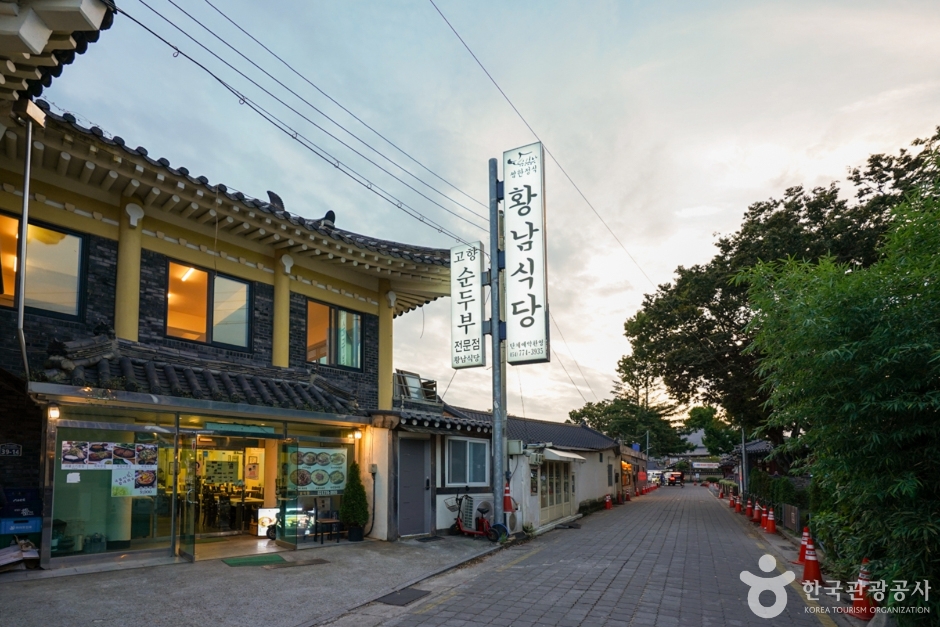
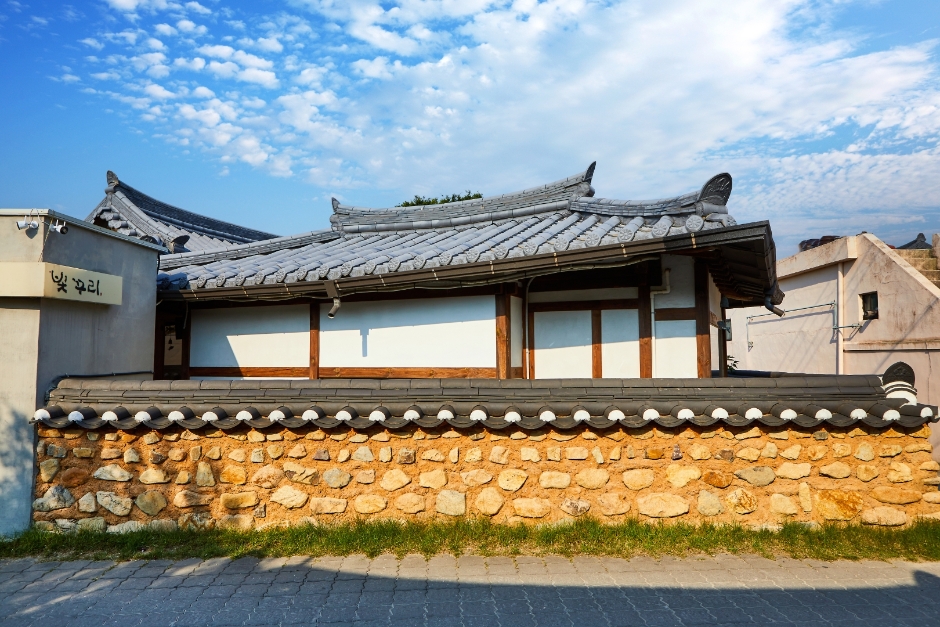
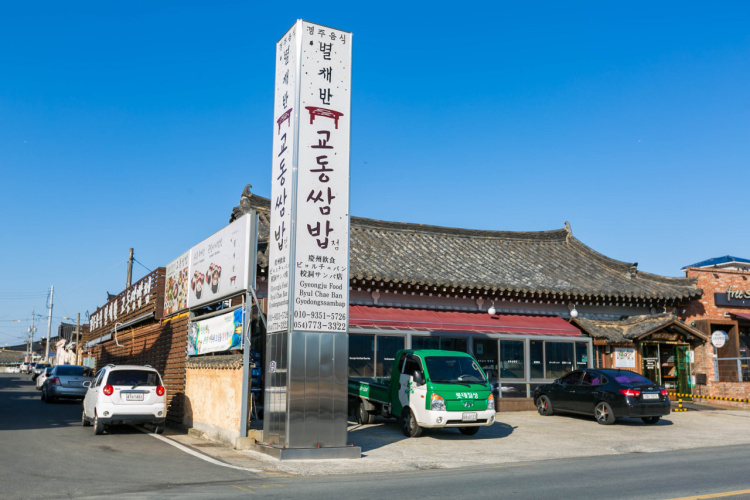
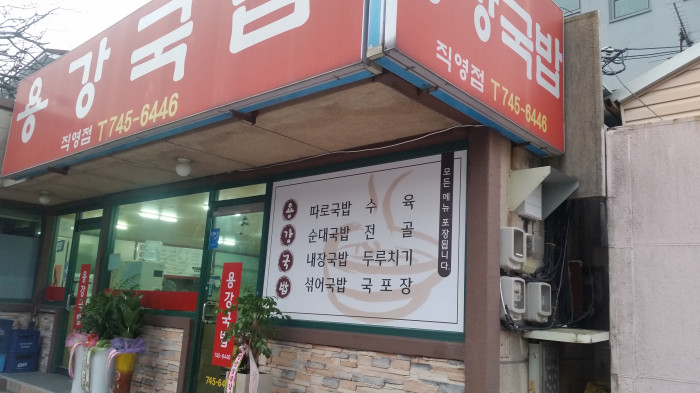
![GyeongjuCheonnyeonhanok Pension [Korea Quality] / 경주천년한옥펜션 [한국관광 품질인증]](http://tong.visitkorea.or.kr/cms/resource/35/2635535_image2_1.jpg)
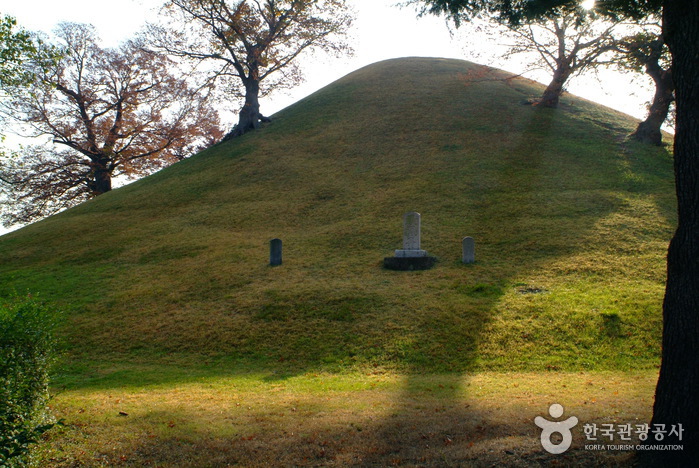
 English
English
 한국어
한국어 日本語
日本語 中文(简体)
中文(简体) Deutsch
Deutsch Français
Français Español
Español Русский
Русский